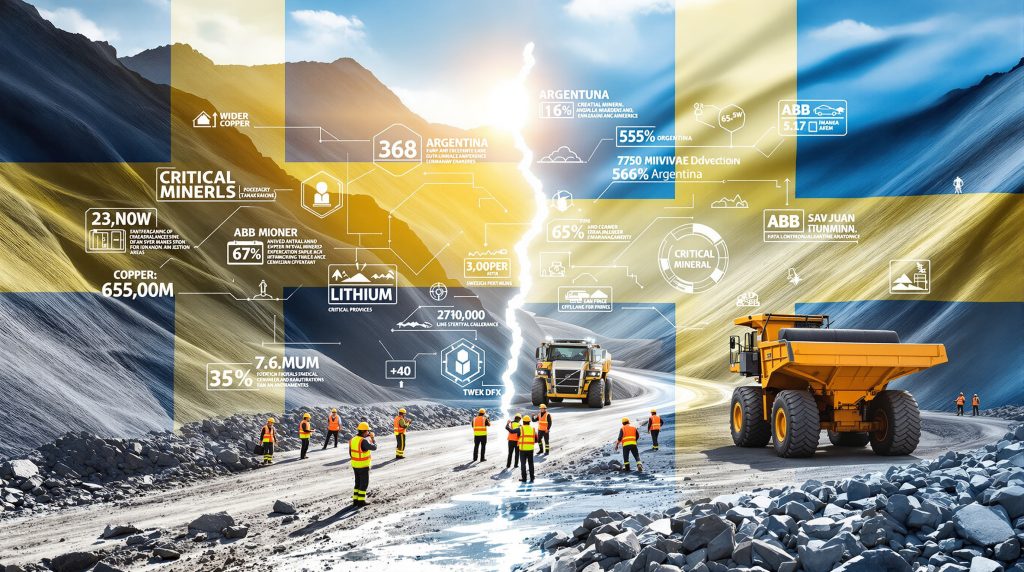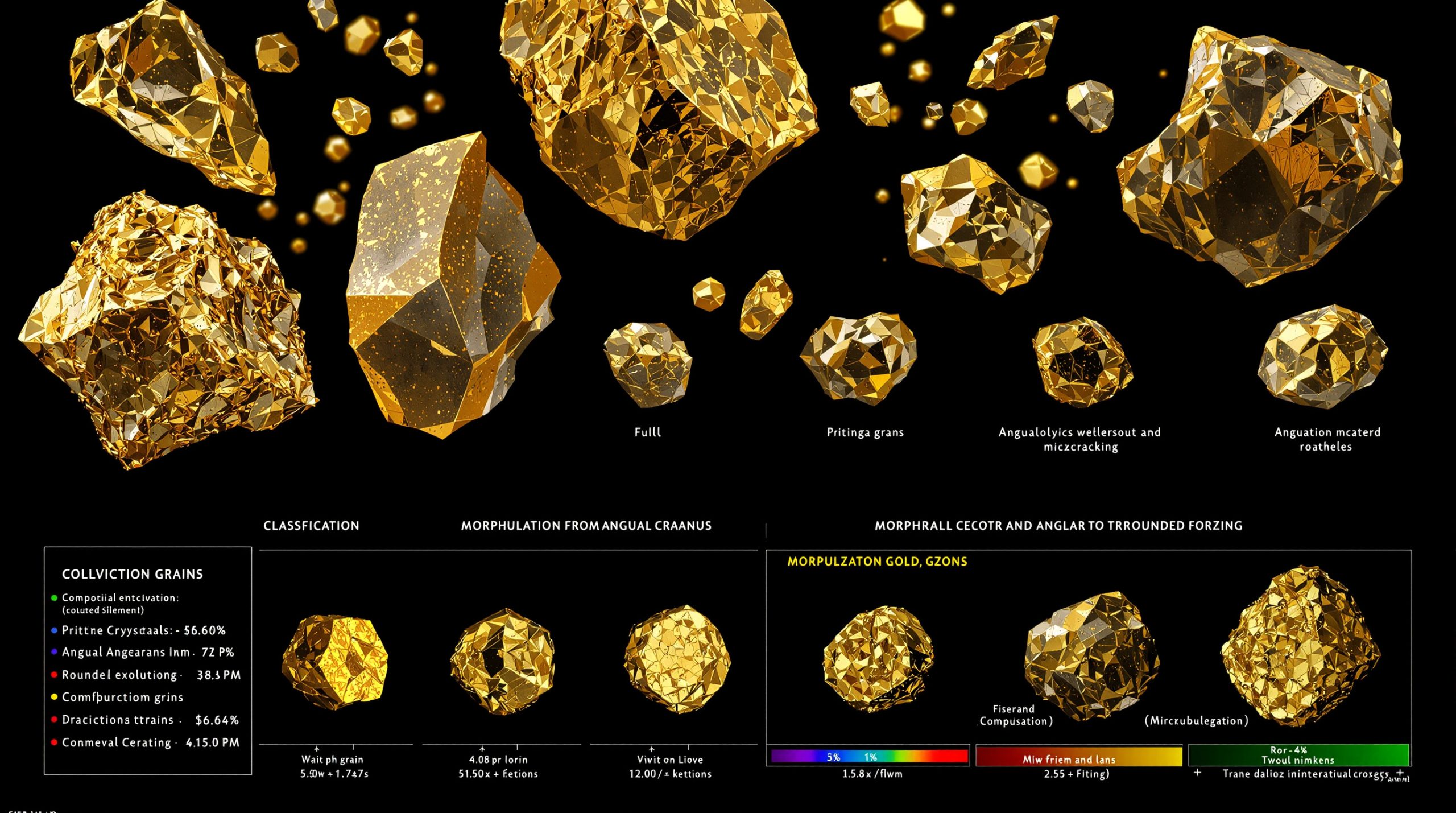What Makes Argentina a Strategic Mining Partner for Sweden and Europe?
Argentina's vast mineral reserves, democratic governance, and growing focus on critical minerals position it as a natural strategic partner for Sweden and Europe. This partnership addresses Europe's urgent need to diversify mineral supply chains away from Chinese dominance while leveraging Sweden's technological expertise in sustainable mining industry innovation.
The collaboration comes at a crucial time as Europe seeks greater resource independence amid global supply chain disruptions. With 80% of San Juan Province's exports already concentrated in mining—primarily gold and lime—Argentina offers significant potential for expanded production of critical energy minerals needed in renewable energy technologies and digital transformation.
Key Strategic Benefits of the Partnership
The Argentina-Sweden mining partnership delivers multiple strategic advantages for both nations, creating a foundation for long-term cooperation that extends beyond mere commercial interests.
First, Argentina possesses significant reserves of critical minerals essential for the global energy transition. The country's mineral wealth includes copper, lithium, and rare earth elements that are fundamental components in renewable technologies like solar panels, wind turbines, and battery storage systems.
Sweden brings over a thousand years of mining expertise and cutting-edge technological innovation to the partnership. As Europe's leader in iron production and mining technology, Sweden's knowledge in underground mining techniques, automation, and electrification can dramatically improve productivity and sustainability in Argentina's developing mining sector.
The alliance supports Europe's strategic objective of securing critical mineral supply chains. As noted by Ventsislav Benov, CEO of Arc Fund, "Europe must diversify its mining dependence away from China," positioning Latin America—with Argentina as a key player—as an emerging strategic ally in resource security.
Both nations share democratic values and commitment to environmental standards, making the partnership more stable and aligned with global sustainability goals. This value alignment ensures mining development proceeds with proper environmental safeguards and community benefits.
Finally, the partnership creates valuable opportunities for technology transfer and economic development in Argentina's mining regions, fostering local expertise and creating sustainable mining communities through a "triple helix" model connecting government, academia, and the private sector.
How Is Sweden Positioning Itself in the Global Mining Landscape?
Sweden has established itself as a European mining leader through its focus on technological innovation, sustainability practices, and strategic international partnerships. While maintaining strong domestic mineral production, Sweden is expanding its global influence through collaborative initiatives with mineral-rich nations like Argentina.
Ambassador Torsten Ericsson highlighted Sweden's millennial mining tradition during the Swedish Mining Initiative 2025 forum, noting that the country not only leads Europe in iron production but also pioneers technological innovation in the mining sector. This technological leadership encompasses advanced underground mining techniques, automation systems, and electrification solutions that can transform operations in developing mining regions.
Sweden's Mining Strengths and Global Strategy
Sweden's position as a European leader in iron production and mining technology innovation gives it significant influence in the global mining sector. The country's mining industry has continuously evolved over centuries, adapting to changing economic and environmental demands while maintaining its competitive edge.
Swedish companies have pioneered advanced underground mining techniques, automation, and electrification that increase productivity while reducing environmental impacts. This expertise is particularly valuable for developing mining nations seeking to modernize their operations according to global best practices.
The country maintains a strategic focus on forming partnerships with mineral-rich democratic nations that share Sweden's values regarding environmental protection and community engagement. This approach ensures more stable and ethical supply chains for critical energy minerals needed in European industries.
Sweden has demonstrated a strong commitment to exporting sustainable mining practices and environmental standards that have been developed through its long history of balancing resource extraction with environmental protection. This expertise is increasingly valuable as mining companies worldwide face growing pressure to reduce their environmental footprints.
Through diplomatic and commercial channels, Sweden is actively leveraging its technological expertise and sustainability credentials to secure critical mineral access for European industries. The partnership with Argentina represents a concrete example of this strategy in action.
What Are the Three Pillars of the Argentina-Sweden Mining Collaboration?
The partnership between Argentina and Sweden rests on three fundamental pillars that combine technological advancement with sustainable development principles. These pillars form the foundation for long-term cooperation that benefits both nations while addressing global challenges.
As outlined by Ambassador Torsten Ericsson at the Swedish Mining Initiative 2025 forum, these pillars represent a comprehensive approach to mining development that goes beyond simple resource extraction to encompass technology transfer, environmental stewardship, and human capital development.
The Three Core Partnership Elements
-
Advanced Technology Transfer: Swedish companies including Volvo, ABB, Epiroc, Uddeholm, and Hitachi Energy are bringing cutting-edge mining technologies to Argentina's developing sector. This technology transfer encompasses advanced mining equipment, automation systems, electrification solutions, and specialized steel products that can significantly improve productivity and safety in Argentine mining operations. The involvement of these world-class companies demonstrates Sweden's commitment to supporting Argentina's mining modernization with practical technological solutions.
-
Environmental Best Practices: Implementation of world-class environmental standards and sustainable resource management techniques developed through Sweden's long mining history forms the second pillar. Sweden has spent decades refining approaches to minimize mining's environmental impacts, including water management, waste reduction, mine reclamation strategies, and energy efficiency. These practices are being adapted to Argentina's specific geological and ecological contexts to ensure responsible resource development that protects the country's natural heritage while supporting economic growth.
-
Local Talent Development: Creation of a "triple helix" model connecting government, academia, and private sector to build local expertise and create sustainable mining communities represents the third pillar. This approach recognizes that technological solutions alone cannot create sustainable mining industries—human capital development is equally important. By fostering collaboration between universities, mining companies, and government agencies, the partnership aims to develop a skilled local workforce capable of managing advanced mining operations while creating lasting economic benefits for mining communities.
How Is San Juan Province Leading Argentina's Mining Development?
San Juan Province has emerged as Argentina's mining powerhouse, with progressive policies attracting significant investment and positioning itself as a model for other provinces. Under Governor Marcelo Orrego's leadership, the province has created favorable conditions for responsible mining development.
During the Swedish Mining Initiative 2025 forum, Governor Orrego presented San Juan's comprehensive approach to mining development, emphasizing both the province's natural advantages and policy innovations that have made it Argentina's leading mining jurisdiction.
San Juan's Mining Leadership Approach
Mining has been established as a long-term state policy in San Juan with strong institutional support, creating predictability and stability for investors. Governor Orrego emphasized that the province offers legal security, process transparency, and social consensus as its principal strengths for capturing responsible investments.
The province's geography provides natural advantages, with 83% mountainous terrain naturally suited for mineral extraction. This topographical characteristic makes mining a logical economic development path while limiting conflicts with other land uses such as agriculture.
San Juan's exports are already 80% concentrated in mining, primarily gold and lime, demonstrating the sector's existing economic importance. This established mining foundation provides infrastructure, expertise, and supply chains that can support further development.
The province has implemented a strategic pivot to copper development as a future growth driver. Governor Orrego articulated this vision clearly: "Mining is present, but above all it is future. If that future is green, it will be with more copper. And if that copper is Argentine, it will be largely from San Juan."
San Juan has captured 40% of national RIGI (Large Investment Incentive Regime) applications, reflecting investor confidence in the province's mining potential and regulatory framework. This impressive concentration demonstrates San Juan's competitive advantage in attracting mining investment.
The province has secured committed investment of approximately US$13.2 billion in provincial mining projects, representing a significant capital influx that will drive economic development across multiple sectors. These investments span exploration, mine development, and supporting infrastructure.
San Juan has digitalized mining approval processes and streamlined environmental impact assessments through its Ministry of Mining, having evaluated 80 environmental impact reports at various project stages. This digital transformation reduces bureaucratic barriers while maintaining environmental oversight.
The province maintains a balanced approach requiring environmental protection and community benefits alongside mineral development. Governor Orrego's position is clear: "San Juan does not want mining at any cost. We want mining that cares for the environment, respects communities, and leaves a legacy of prosperity for future generations."
What Critical Minerals Are Driving the Partnership?
The Argentina-Sweden mining partnership focuses primarily on minerals essential for the global energy transition and digital transformation. These strategic resources are becoming increasingly important as the world shifts toward renewable energy and advanced technologies.
Ambassador Ericsson specifically highlighted the importance of minerals critical for "batteries, turbines, and technologies associated with combating climate change" as a key driver of the partnership. These resources are central to both countries' strategic interests, with Argentina possessing significant reserves and Sweden contributing technological expertise for their extraction and processing.
Key Minerals in the Strategic Relationship
Lithium stands as perhaps the most strategic mineral in the partnership, essential for battery production and energy storage systems. Argentina forms part of the "Lithium Triangle" along with Bolivia and Chile, hosting approximately 21% of the world's known lithium reserves. As electric vehicle adoption accelerates globally, lithium demand is projected to increase dramatically, making Argentina's resources increasingly valuable. Lithium industry innovations were discussed during the Swedish Mining Initiative forum, with representatives from Eramet Sudamericana and Lithium Argentina highlighting both the potential and challenges in developing this sector.
Copper represents another critical mineral driving the partnership, essential for electrical infrastructure, renewable energy systems, and electric vehicles. San Juan Province is strategically positioning itself as Argentina's copper powerhouse, with Governor Orrego emphasizing that "if that future is green, it will be with more copper." Projects like "Los Azules" promise 21 years of clean copper production with RIGI support, demonstrating the mineral's long-term economic potential. Copper market insights suggest demand will grow substantially as electrification expands globally, making Argentina's underdeveloped copper resources increasingly strategic.
Rare Earth Elements are required for wind turbines, electric motors, and high-tech applications, making them crucial components of the clean energy transition. While less discussed in the forum transcript, these minerals represent an important part of the critical mineral landscape that both countries recognize as strategic for future technologies.
Iron remains fundamental for infrastructure development and industrial applications, and represents Sweden's traditional mining strength. As Europe's leader in iron production, Sweden brings particularly valuable expertise in this sector that can help Argentina develop its own iron resources more effectively.
Gold continues to serve as both a traditional store of value and has important industrial applications in electronics. San Juan Province already derives significant export revenue from gold production, making it an established part of the mining relationship that provides economic foundation while newer mineral sectors develop.
What Challenges Must Be Overcome for Partnership Success?
Despite strong diplomatic and commercial alignment, significant practical challenges remain before the Argentina-Sweden mining partnership can reach its full potential. Industry experts highlighted several key obstacles during the Swedish Mining Initiative 2025 forum.
Manuel Giménez Zapiola of Eramet Sudamericana emphasized infrastructure as a critical bottleneck, stating bluntly: "Roads, freight trains, and effective energy transport are needed." This assessment highlights the gap between Argentina's mineral potential and the practical requirements for bringing that potential to market.
Critical Obstacles to Partnership Implementation
Infrastructure Deficiencies represent perhaps the most significant immediate challenge, with inadequate roads, rail systems, and energy transmission networks limiting development. Mining projects often require substantial transportation infrastructure to move equipment in and minerals out, as well as reliable energy supplies for operations. Governor Orrego explicitly called for national government support with infrastructure projects to strengthen mineral production chains, indicating this remains a significant bottleneck.
Regulatory Consistency is essential for attracting the long-term capital investments that mining requires. Henrik Hallgren of the Swedish Industry Council (NIR) emphasized that stability of public policies and institutional consistency are essential conditions for investments to flow. Mining projects typically require 5-10 years of development before production begins, making policy predictability across political cycles particularly important.
Federal-Provincial Coordination presents complex jurisdictional relationships requiring alignment between different levels of government. Argentina's federal system gives provinces primary authority over mineral resources, but national policies on taxation, export regulations, and currency controls significantly impact project economics. This multi-level governance structure can create coordination challenges that slow development.
Project Execution Gap represents a critical challenge, with Ignacio Celorrio of Lithium Argentina noting that although expectations are high, "the scenario is more of potential than leadership," with significant differences between promising projects and concrete execution. This highlights the need to bridge the divide between identified mineral resources and operational mines producing commercial output.
Environmental Standards Implementation requires translating sustainability commitments into practical operations with measurable outcomes. While both countries emphasize environmental responsibility in principle, the practical application of world-class environmental standards in Argentina's developing mining sector will require significant technical capacity building and regulatory oversight.
Community Engagement remains essential for building and maintaining social license to operate in mining regions. Governor Orrego's emphasis on mining that "respects communities and leaves a legacy of prosperity for future generations" reflects awareness of this challenge, but implementation requires ongoing dialogue, benefit-sharing mechanisms, and conflict resolution processes.
Value Chain Development beyond raw material extraction represents a strategic challenge and opportunity. Creating domestic processing capabilities that capture more economic value from mineral resources requires additional investment, technical expertise, and supportive policies that the partnership is still developing.
How Does the Partnership Address Global Sustainability Challenges?
The Argentina-Sweden mining collaboration explicitly positions responsible mineral extraction as part of the solution to global sustainability challenges. This approach recognizes that the energy transition and climate action require minerals produced with minimal environmental impact.
Ambassador Ericsson articulated this perspective clearly, stating that "the mining can and must be part of the solution to major global challenges." This framing shifts the narrative from mining as an environmental problem to mining as an essential enabler of environmental solutions—provided it adheres to high standards of responsibility.
Mining as a Sustainability Solution
Critical minerals enable renewable energy technologies and electrification essential for reducing carbon emissions. Lithium for batteries, copper for electrical systems, and rare earth elements for wind turbines and electric motors are all fundamental components of climate solutions. The partnership recognizes that without these minerals, the global energy transition cannot proceed at the necessary pace.
Swedish technological innovations help reduce mining's environmental footprint through more efficient extraction methods, automation, electrification, and digitalization. These technologies can significantly decrease energy and water consumption, reduce waste generation, and minimize land disturbance compared to conventional mining approaches.
The partnership emphasizes ethical sourcing and respect for local communities as core principles, recognizing that social sustainability is equally important as environmental protection. Governor Orrego's statement that San Juan wants "mining that cares for the environment, respects communities, and leaves a legacy of prosperity for future generations" encapsulates this integrated approach.
Water usage minimization and implementation of circular economy principles represent key technical focuses of the partnership. Sweden's expertise in water management and material recycling can help address mining's traditionally high water consumption and waste generation, particularly important in water-stressed regions of Argentina.
Transparent environmental monitoring and reporting systems create accountability and build public trust in mining operations. The partnership aims to implement world-class monitoring protocols that provide real-time data on environmental performance and early warning of potential issues.
Development of mining techniques that preserve biodiversity and ecosystem health remains a technical priority. Swedish expertise in land rehabilitation, habitat protection, and minimizing ecological disruption can help ensure mining development proceeds with minimal long-term environmental impact.
Integration of mining operations with broader sustainable development goals ensures the sector contributes positively to local communities and national prosperity. The "triple helix" model connecting government, academia, and private sector provides a framework for aligning mining development with educational, infrastructure, and community development objectives.
What Role Do Swedish Companies Play in Argentina's Mining Development?
Swedish companies bring world-class expertise and technologies that can transform Argentina's mining sector. Their involvement extends beyond equipment supply to include comprehensive solutions for more efficient, safer, and environmentally responsible mining operations.
Ambassador Ericsson specifically highlighted the role of companies including Volvo, ABB, Epiroc, Uddeholm, and Hitachi Energy in the technology transfer pillar of the partnership. These companies represent global leaders in their respective fields, bringing decades of experience in mining equipment, automation, electrification, and specialized materials.
Swedish Corporate Contributions to Argentine Mining
Volvo & Scania provide advanced transportation and logistics solutions for mining operations, including specialized trucks designed for the demanding conditions of mining sites. These vehicles incorporate fuel efficiency technologies, driver assistance systems, and durability features that improve productivity while reducing environmental impacts. Both companies participated in the Swedish Mining Initiative 2025 forum, focusing on logistics and heavy transportation as key elements for consolidating competitive mining chains.
ABB contributes automation, electrification, and digital solutions for mining efficiency that can transform traditional operations into more productive and sustainable systems. ABB's technologies include electric drive systems for mining vehicles, automated process controls, and digital monitoring systems that optimize energy use and maintenance scheduling while improving safety.
Epiroc supplies cutting-edge drilling and excavation equipment with automation capabilities that increase productivity while reducing operator risk. The company's technologies include precision drilling systems, automated loading equipment, and real-time monitoring tools that improve ore recovery rates while minimizing energy consumption and waste generation.
Uddeholm provides specialized steel products and wear-resistant materials for mining applications that extend equipment lifespan and improve operational reliability. These specialized materials can significantly reduce maintenance requirements and downtime in the harsh operating environments typical of mining operations.
Hitachi Energy delivers power systems and grid solutions for mining operations that ensure reliable electricity supply while integrating renewable energy sources where possible. These systems are particularly important for remote mining sites that may operate independently from national power grids.
Swedish Engineering Firms offer consulting services for mine design and environmental management, bringing experience from Sweden's long history of balancing mining with environmental protection. These firms help adapt international best practices to Argentina's specific geological, environmental, and regulatory context.
Swedish Financial Institutions provide investment and risk management expertise for mining projects, helping mobilize the substantial capital required for mine development. Mining projects typically require significant upfront investment before generating returns, making financial expertise particularly valuable for project development.
How Does the RIGI Framework Support Mining Investment in Argentina?
Argentina's recently implemented Large Investment Incentive Regime (RIGI) has become a crucial tool for attracting mining investment, particularly from international partners like Sweden. The framework provides stability and incentives that address historical concerns about Argentina's investment climate.
Governor Orrego highlighted that 40% of total national RIGI applications correspond to projects in San Juan Province, with committed investments of approximately US$13.2 billion. This concentration demonstrates both San Juan's mining potential and the importance of the RIGI framework in unlocking investment capital.
RIGI's Impact on Mining Development
The regime creates predictable fiscal and regulatory conditions for large-scale investments, addressing one of the primary concerns international investors have historically had about Argentina. Mining projects typically require 5-10 years of development before production begins, making long-term policy predictability particularly important.
RIGI provides tax stability and customs benefits for qualifying mining projects, reducing the financial risk associated with potential policy changes. These benefits include stable tax rates, accelerated depreciation, and reduced import duties on capital equipment necessary for mine development.
The framework allows free capital movement and dividend repatriation for foreign investors, addressing another historical concern about Argentina's currency controls. This flexibility is particularly important for international mining companies that need to deploy capital globally and return profits to shareholders.
RIGI reduces bureaucratic barriers to project development and operation through streamlined approval processes and clear regulatory guidelines. This administrative simplification helps projects advance more quickly from exploration to development to production phases.
The regime encourages long-term planning with 30-year guarantees for major projects, providing the stability horizon necessary for mining investments that may have operational lifespans of several decades. This extended timeframe aligns with the reality of mining project economics and life cycles.
RIGI directly addresses historical concerns about Argentina's investment predictability by creating legally binding commitments that transcend political cycles. This stability is particularly valuable given Argentina's history of policy volatility that has deterred some international investors.
The framework helps attract international capital essential for developing capital-intensive mining projects that might otherwise struggle to secure financing. Mining requires substantial upfront investment in exploration, engineering, equipment, and infrastructure before generating returns, making access to international capital markets crucial.
What Future Developments Can We Expect from the Partnership?
The Argentina-Sweden mining partnership is positioned for significant growth as both countries deepen their collaboration. Several key developments are likely to emerge in the coming years as the relationship matures and initial projects demonstrate success.
The Swedish Mining Initiative 2025 forum represented an important step in strengthening this relationship, bringing together over 100 leaders from government, business, and academia to explore practical cooperation opportunities. As Henrik Hallgren of the Swedish Industry Council (NIR) noted, Argentina is "a mining country of the future," but realizing that potential will require sustained cooperation.
Expected Partnership Evolution
Expansion from diplomatic frameworks to concrete joint venture projects represents the next logical step in the partnership's development. While the relationship currently exists primarily at the diplomatic and commercial levels, deeper integration through formal joint ventures between Swedish and Argentine companies would strengthen implementation capabilities.
Development of specialized educational programs focused on mining technologies would advance the talent development pillar of the partnership. These programs could include technical training, university degrees, and executive education initiatives that build Argentina's human capital in modern mining techniques.
Creation of innovation hubs connecting Swedish expertise with Argentine resources could accelerate technology adaptation and development. These centers would focus on adapting Swedish technologies to Argentina's specific geological, environmental, and social contexts while fostering innovation in mining processes and environmental management.
Establishment of demonstration projects showcasing sustainable mining practices would provide concrete examples of the partnership's benefits. These projects could serve as learning laboratories and proof points for wider adoption of Swedish technologies and environmental standards across Argentina's mining sector.
Formation of industry clusters supporting the mining supply chain would create economic multiplier effects beyond direct mining operations. These clusters would include equipment manufacturers, maintenance services, logistics providers, and specialized consultancies that create additional employment and economic activity.
Integration of mining operations with renewable energy development represents a natural synergy, particularly in remote mining regions. Swedish expertise in renewable energy systems combined with Argentina's abundant solar and wind resources could create mining operations powered by clean energy, further reducing environmental impacts.
Advancement of value-added processing to capture more economic benefits locally would move beyond raw material extraction toward higher-value activities. Processing facilities that convert raw minerals into refined materials or components would create additional economic value and employment opportunities within Argentina.
FAQ: Argentina-Sweden Mining Partnership
Why is Europe interested in Argentina's mineral resources?
Europe seeks to reduce its dependence on Chinese mineral supplies for strategic autonomy. China currently dominates global supply chains for many critical minerals, including rare earth elements, lithium processing, and various technology metals. This concentration creates vulnerability for European industries that depend on these materials for everything from renewable energy technologies to defense applications.
Argentina offers democratic governance, significant mineral reserves, and alignment with European environmental and social standards, making it an ideal partner for securing critical minerals needed for the green transition. As Ventsislav Benov, CEO of Arc Fund, noted during the Swedish Mining Initiative forum, "Europe must diversify its mining dependence away from China," positioning Latin America—with Argentina as a key player—as an emerging strategic ally.
The partnership also aligns with Europe's broader sustainability goals, as Argentina's minerals can be developed according to high environmental and social standards that align with European values. This ethical sourcing is increasingly important for European manufacturers who face both regulatory requirements and consumer expectations regarding supply chain responsibility.
What makes Swedish mining technology unique?
Swedish mining technology is distinguished by its focus on automation, electrification, digitalization, and environmental efficiency. These innovations reflect Sweden's need to maintain competitiveness despite high labor costs and stringent environmental regulations—conditions that have driven continuous technological innovation.
Sweden's millennium of mining experience has produced innovations in underground mining, ore processing, and sustainable resource management that can significantly improve productivity and reduce environmental impacts in Argentina's developing mining sector. This experience spans from traditional methods to cutting-edge digital technologies that optimize every aspect of mining operations.
Key technological strengths include automated drilling and loading systems that improve precision and safety; electric mining equipment that eliminates diesel emissions underground; digital twins and real-time monitoring systems that optimize operations; and advanced water management and waste reduction techniques that minimize environmental footprints.
These technologies align particularly well with Argentina's needs to develop its mining sector efficiently while meeting growing expectations for environmental and social responsibility. By adopting Swedish technologies, Argentina can potentially leapfrog decades of incremental development to implement best-in-class mining practices from the outset.
How does the partnership benefit local Argentine communities?
The partnership emphasizes local talent development, environmental protection, and community engagement as core principles. This approach recognizes that sustainable mining development must create benefits beyond the mine site itself to gain and maintain social license to operate.
Swedish companies bring not only technology but also best practices in corporate social responsibility, creating opportunities for skills development, local business growth, and sustainable community development around mining operations. These practices include inclusive hiring policies, local supplier development programs, and community investment initiatives that build long-term relationships.
The "triple helix" model connecting government, academia, and private sector creates structured pathways for local talent development and knowledge transfer. This model can create educational opportunities from technical training to advanced degrees that prepare local residents for high-skilled roles in the mining sector.
Environmental protection measures help preserve natural resources that communities depend upon, while robust environmental monitoring creates transparency and accountability. Swedish expertise in minimizing impacts on water resources, biodiversity, and air quality helps ensure mining development doesn't compromise community health or traditional livelihoods.
Revenue sharing and community investment programs can provide tangible benefits like improved infrastructure, healthcare, and education facilities that improve quality of life in mining regions. When properly structured, these programs ensure that mineral wealth creates lasting community development rather than temporary economic booms.
What role does copper play in Argentina's mining future?
Copper is emerging as a strategic priority for Argentina's mining sector, particularly in provinces like San Juan. Governor Orrego articulated this vision clearly: "Mining is present, but above all it is future. If that future is green, it will be with more copper. And if that copper is Argentine, it will be largely from San Juan."
As a critical mineral for renewable energy infrastructure and electrification, copper demand is projected to grow substantially in coming decades. The International Energy Agency estimates that a typical electric car requires four times as much copper as a conventional vehicle, while renewable power generation is significantly more copper-intensive than fossil fuel alternatives.
Argentina's underdeveloped copper resources represent a significant economic opportunity that the partnership with Sweden can help realize through technological support and investment. Projects like "Los Azules" promise 21 years of clean copper production with RIGI support, demonstrating the long-term economic potential of copper development.
San Juan Province's geological characteristics make it particularly suitable for copper mining, with its mountainous terrain (83% of provincial territory) hosting significant copper deposits. The province is strategically positioning itself to become Argentina's copper powerhouse, building on its existing mining expertise and infrastructure.
Copper mining can create more diversified economic benefits than some other mineral developments, with opportunities for domestic processing and manufacturing that capture additional value from the resource. The partnership's focus on value chain development could help Argentina move beyond raw material extraction to higher-value activities.
How does the partnership address environmental concerns about mining?
The collaboration explicitly focuses on implementing world-class environmental standards and sustainable mining practices. This emphasis reflects both countries' recognition that environmental responsibility is essential for mining's social acceptance and long-term viability.
Swedish expertise in reducing environmental impacts, water management, energy efficiency, and mine rehabilitation helps ensure that Argentina's mineral resources can be developed responsibly with minimal ecological footprint. Sweden has spent decades refining approaches to balance mining with environmental protection, creating techniques and technologies that can be adapted to Argentina's context.
The partnership incorporates environmental considerations from the earliest stages of project planning rather than treating them as afterthoughts. This integrated approach helps identify and address potential impacts before they occur, reducing remediation costs and environmental risks.
Water management receives particular attention given both mining's typically high water requirements and the water scarcity in many Argentine mining regions. Swedish technologies for water recycling, treatment, and monitoring can significantly reduce freshwater consumption and potential contamination risks.
Transparent environmental monitoring and reporting systems create accountability and build public trust in mining operations. These systems provide real-time data on environmental performance that can be shared with regulators and communities, creating confidence that operations maintain compliance with standards.
Biodiversity protection and land rehabilitation are incorporated into mining plans to ensure that post-mining landscapes maintain ecological functions and values. These approaches help ensure that mining represents a temporary land use rather than permanent environmental degradation.
Energy efficiency and renewable integration reduce both carbon footprints and operating costs. Swedish mining equipment manufacturers are global leaders in energy-efficient designs, while Sweden's expertise in renewable energy can help Argentine mining operations reduce dependence on fossil fuels.
Ready to Capitalise on the Next Major Mining Discovery?
Discover investment opportunities in significant mineral discoveries across the ASX with Discovery Alert's proprietary Discovery IQ model, which instantly transforms complex mineral data into actionable insights. Explore historic discoveries and their exceptional returns on our dedicated discoveries page and position yourself ahead of the market with our 30-day free trial.




